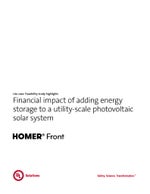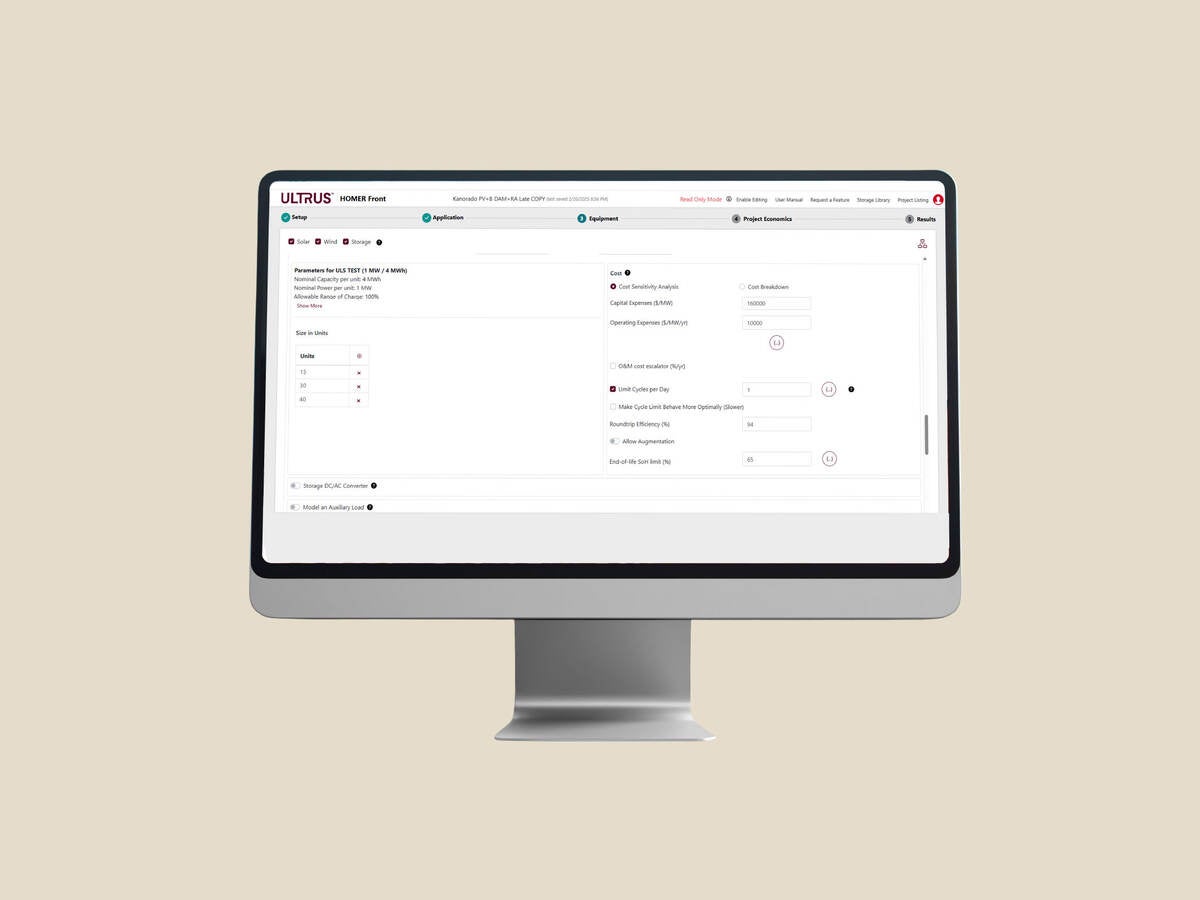
HOMER Modeling Financial Impact in CA
Unlock the potential of renewable energy projects with ULTRUS™ HOMER® Front 1.2 software, empowering developers to optimize storage, enhance profitability and navigate complex energy markets efficiently.

As renewable energy continues to transform the power sector, energy developers face increasingly complex challenges. The variability of wind and solar generation, the high costs of battery storage, and the intricacies of energy market participation make project optimization a daunting task. Enter ULTRUS™HOMER® Front, a cutting-edge hybrid optimization software designed to help project developers and engineers optimize as well as maximize the value of energy storage and hybrid systems.
Now, with the release of HOMER® Front 1.2, the software introduces key new features that enhance flexibility, improve financial modeling and streamline workflows — offering even greater precision in project planning and decision-making.
For energy storage and hybrid power projects to be successful, they must be financially viable, technically efficient and strategically positioned within energy markets. However, achieving this balance is far from simple. Battery degradation, fluctuating energy prices and evolving grid regulations create uncertainty, making it difficult to determine the best system configuration and dispatch strategy.
HOMER® Front software addresses these challenges head on. By enabling detailed modeling of battery energy storage systems (BESS) and hybrid power plants, the software helps users analyze project feasibility, predict long-term performance and optimize financial returns. Developers can assess how different system sizes, revenue streams and operating strategies impact the bottom line — before development costs increase.
Building on its strong analytical foundation, the latest release — HOMER® Front 1.2 — delivers several game-changing enhancements.
One of the most notable updates is the ability to separate component lifetimes within a project. Previously, all system components had to be modeled with fixed start and end dates, limiting flexibility. Now, users can introduce new technologies at different stages of a project’s life cycle, allowing for incremental system upgrades and phased deployments — a critical advantage in today’s rapidly evolving energy landscape.
For battery energy storage systems, HOMER® Front 1.2 software introduces a more flexible degradation and augmentation framework. Users are no longer required to define an augmentation strategy; instead, they can optionally set a state-of-health (SOH) limit, allowing the system to retire batteries once they reach a predetermined threshold. This feature provides more accurate and adaptive options for life cycle modeling.
Additionally, HOMER® Front 1.2 software automates key calculations, such as degradation costs and temperature impacts within the storage library. This streamlines complex modeling processes so that users can more quickly receive more precise insights into their project's long-term viability.
With the rise of renewables, the market for energy storage is more competitive than ever. Developers need tools that allow them to design projects with confidence, secure financing more easily and maximize profitability — and this is where HOMER® Front software excels.
By optimizing system sizing, the software helps reduce over-investment in unnecessary capacity while establishing that energy storage assets are large enough to deliver reliable performance. Its advanced market modeling capabilities allow users to evaluate multiple revenue streams, from wholesale market participation to capacity payments and ancillary services, helping them capitalize on multiple income opportunities.
Moreover, the HOMER® Front software’s ability to run detailed financial and operational simulations means fewer surprises down the road. Projects built on well-informed models are more likely to succeed, attract investors and achieve higher internal rates of return (IRR).
As energy storage and hybrid systems become increasingly central to the global energy transition, precision in project design and financial modeling has never been more important. The HOMER® Front software continues to lead the way in helping energy professionals navigate the complexity of today’s energy markets.
With the new capabilities in HOMER® Front 1.2 software, developers gain even more control over their project timelines, storage strategies and financial planning — empowering them to make the most of the opportunities ahead. Whether you're designing a utility-scale BESS, a hybrid solar-plus-storage system, or a wind-integrated energy project, HOMER® Front remains go-to software for optimizing performance, managing risk and maximizing value.
Thanks for your interest in our products and services. Let's collect some information so we can connect you with the right person.